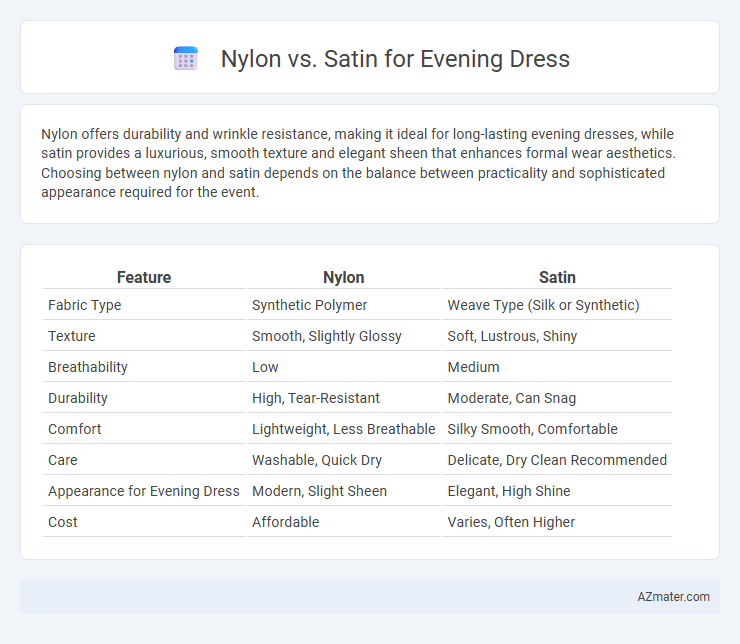Nylon offers durability and wrinkle resistance, making it ideal for long-lasting evening dresses, while satin provides a luxurious, smooth texture and elegant sheen that enhances formal wear aesthetics. Choosing between nylon and satin depends on the balance between practicality and sophisticated appearance required for the event.
Table of Comparison
| Feature | Nylon | Satin |
|---|---|---|
| Fabric Type | Synthetic Polymer | Weave Type (Silk or Synthetic) |
| Texture | Smooth, Slightly Glossy | Soft, Lustrous, Shiny |
| Breathability | Low | Medium |
| Durability | High, Tear-Resistant | Moderate, Can Snag |
| Comfort | Lightweight, Less Breathable | Silky Smooth, Comfortable |
| Care | Washable, Quick Dry | Delicate, Dry Clean Recommended |
| Appearance for Evening Dress | Modern, Slight Sheen | Elegant, High Shine |
| Cost | Affordable | Varies, Often Higher |
Introduction to Nylon and Satin Fabrics
Nylon is a synthetic fabric known for its strength, elasticity, and resistance to wrinkles and abrasions, making it a durable choice for evening dresses. Satin, characterized by its smooth, glossy surface and luxurious drape, is traditionally crafted from silk or synthetic fibers like polyester or nylon. Both fabrics offer distinctive textures and finishes that influence the overall aesthetic and comfort of evening wear.
Key Differences Between Nylon and Satin
Nylon is a synthetic fiber known for its durability, elasticity, and moisture-wicking properties, making it a practical choice for evening dresses that require resilience and comfort. Satin refers to a weaving technique that creates a glossy, smooth surface, which can be made from various fibers including nylon, silk, or polyester; its luxurious sheen and fluid drape offer a distinctive elegant appearance. The key differences lie in nylon being a fabric material with strong performance features, while satin is defined by its texture and finish, often chosen for its aesthetic appeal in formal wear.
Texture and Feel: Nylon vs Satin
Nylon fabric offers a smooth, lightweight texture with a slight sheen, making it durable and resistant to wrinkles, ideal for evening dresses requiring structure and flexibility. Satin, characterized by its glossy surface and soft, luxurious feel, provides a fluid drape that enhances elegance and comfort in formal wear. Comparing texture and feel, nylon is more resilient and practical, while satin excels in delivering a rich, silky touch perfect for sophisticated evening attire.
Durability and Strength Comparison
Nylon offers superior durability and strength compared to satin, making it more resistant to tears and abrasions commonly encountered during evening events. Satin, typically made from silk or polyester, provides a luxurious sheen but is more delicate and prone to snagging or fraying under stress. For long-lasting evening dresses, nylon's resilience ensures the garment maintains its structure and appearance through multiple wears and cleanings.
Sheen and Appearance for Evening Wear
Nylon offers a high sheen with a smooth, slightly glossy finish that reflects light well, creating a vibrant and sleek appearance ideal for evening wear. Satin, typically crafted from silk or polyester, boasts a richer, deeper luster with a luxurious, smooth surface that enhances elegance and sophistication in evening dresses. The choice between nylon and satin hinges on the desired level of shine and texture, with satin providing a more opulent glow and nylon delivering a lighter, modern sheen.
Comfort and Breathability Factors
Nylon evening dresses offer durability and a lightweight feel but tend to trap heat and moisture, resulting in less breathability and potential discomfort during extended wear. Satin, often made from silk or polyester blends, provides a smooth, luxurious texture with better airflow, enhancing comfort in warm environments. For optimal breathability and comfort at formal events, satin is generally preferred over nylon due to its superior moisture-wicking and temperature-regulating properties.
Maintenance and Care Requirements
Nylon evening dresses require low maintenance, as the fabric is durable, wrinkle-resistant, and quick-drying, making it easy to wash by hand or machine on a gentle cycle. Satin dresses, often made from silk or polyester blends, demand more delicate care, typically needing dry cleaning or gentle hand washing to preserve the fabric's smooth texture and lustrous finish. Proper storage of satin garments in breathable garment bags prevents snagging and extends the dress's longevity, while nylon's robust nature allows for more flexible handling and storage options.
Cost Analysis: Nylon vs Satin
Nylon evening dresses typically cost less than satin due to nylon's synthetic fibers and mass production efficiencies, making it a budget-friendly option for formal wear. Satin, often made from silk or polyester blends, commands a higher price because of its luxurious feel and sheen, which adds sophistication but increases manufacturing expenses. Consumers seeking elegance on a budget may prefer nylon, while those prioritizing premium texture and appearance often invest in satin despite the higher cost.
Best Occasions for Each Fabric Choice
Nylon evening dresses suit active events such as cocktail parties and dance nights due to their durability and moisture-wicking properties. Satin dresses excel at formal occasions like weddings and galas, offering a luxurious sheen and smooth texture that enhances elegance. Choosing between nylon and satin depends on the event's formality and the desired comfort and aesthetic appeal.
Conclusion: Choosing the Right Fabric for Your Evening Dress
Nylon offers durability, stretch, and moisture resistance, making it ideal for structured evening dresses requiring flexibility and easy care. Satin, known for its lustrous sheen and smooth drape, provides a luxurious, elegant look perfect for formal occasions demanding sophistication. Selecting between nylon and satin depends on balancing comfort, appearance, and event formality to ensure the perfect evening dress fabric.

Infographic: Nylon vs Satin for Evening Dress
 azmater.com
azmater.com